Scare as deadly stonefish found at old port of Mombasa city
Scare as deadly stonefish found at old port of Mombasa city
Scare as deadly stonefish found at old port of Mombasa city
Create successful ePaper yourself
Turn your PDF publications into a flip-book with our unique Google optimized e-Paper software.
<strong>Scare</strong> <strong>as</strong> <strong>deadly</strong> <strong>stonefish</strong> <strong>found</strong> <strong>at</strong> <strong>old</strong> <strong>port</strong> <strong>of</strong><br />
Momb<strong>as</strong>a <strong>city</strong><br />
GLANCE FACTS<br />
Characteristics <strong>of</strong> the <strong>stonefish</strong><br />
It is the most venomous fish known and is up to 35 centimetres long. Synanceia are primarily<br />
marine, though some species are known to live in rivers. Its species have potent neurotoxins<br />
secreted from glands <strong>at</strong> the b<strong>as</strong>e <strong>of</strong> their needle-like dorsal fin spines th<strong>at</strong> stick up when disturbed<br />
or thre<strong>at</strong>ened. The vernacular name <strong>of</strong> the species, the <strong>stonefish</strong>, derives from the <strong>stonefish</strong>’s<br />
ability to camouflage itself with a grey and mottled colour similar to the n<strong>at</strong>ural colour <strong>of</strong> stones.<br />
They <strong>of</strong>ten cannot be seen e<strong>as</strong>ily <strong>as</strong> they look similar to rocks or coral. Swimmers may not notice<br />
them and may inadvertently step on them, triggering poisoning. When the <strong>stonefish</strong> is disturbed,<br />
it may inject an amount <strong>of</strong> venom pro<strong>port</strong>ional to the amount <strong>of</strong> pressure applied to it.<br />
By Linah Benyawa<br />
Standard Monday November 26, 2012<br />
Visitors to beaches in the co<strong>as</strong>tal <strong>city</strong> <strong>of</strong> Momb<strong>as</strong>a will now have to keep a w<strong>at</strong>chful eye<br />
following the emergence <strong>of</strong> a <strong>stonefish</strong>. Authorities have issued a stern warning saying the<br />
heavily poisonous fish h<strong>as</strong> w<strong>as</strong>hed up the shores <strong>of</strong> Momb<strong>as</strong>a’s <strong>old</strong> <strong>port</strong>, occ<strong>as</strong>ioning a scare<br />
among fisheries authorities, swimmers and consumers. Foreign and local tourists visiting the
Kenyan Co<strong>as</strong>t this festive se<strong>as</strong>on have been cautioned to be careful while <strong>at</strong> the beaches after the<br />
venomous species <strong>of</strong> fish w<strong>as</strong> <strong>found</strong> <strong>at</strong> the sea. Belonging to the marine genus Synanceia, the<br />
<strong>stonefish</strong> delivers a poison or neurotoxin th<strong>at</strong> is f<strong>at</strong>al to humans through glands in its dorsal fin.<br />
A fish biologist, R<strong>as</strong>hid Anam, warned on Sunday th<strong>at</strong> this is “the most venomous fish in the<br />
world”, with its sting being highly dangerous and “known to cause de<strong>at</strong>h”. Anam, a marine<br />
scientist <strong>at</strong> the Kenya Marine and Fisheries Institute, warned on Sunday th<strong>at</strong> the most vulnerable<br />
victims <strong>of</strong> the fish’s sting are swimmers because the <strong>stonefish</strong> is a m<strong>as</strong>ter <strong>of</strong> camouflage. He said<br />
most victims are reef walkers while clad in either flimsy shoes or without shoes. “Those visiting<br />
the beaches should be very cautious and should not walk barefooted since the fish sometimes<br />
buries itself in sand and once stepped on, the sting is poisonous leading to de<strong>at</strong>h if one is not<br />
tre<strong>at</strong>ed immedi<strong>at</strong>ely,” he added. On Sunday, fishermen <strong>at</strong> the <strong>old</strong> <strong>port</strong> <strong>of</strong> Momb<strong>as</strong>a netted the fish<br />
and immedi<strong>at</strong>ely warned swimmers about the looming danger. The fish, which had human-like<br />
fe<strong>at</strong>ures such <strong>as</strong> a nose, two eyes and a mouth, shocked locals. Fisherman Abb<strong>as</strong> Musa, who<br />
accidentally caught the fish in his net, w<strong>as</strong> shocked to find the rare species.<br />
Rare and poisonous<br />
“This type <strong>of</strong> fish is very rare and poisonous. It cannot even be touched due to its venomous<br />
n<strong>at</strong>ure and th<strong>at</strong>’s why we were shocked to net it,” said Musa. He added th<strong>at</strong> locals did not need to<br />
be alarmed, but should be aware and cautious. Old Town Fishermen Associ<strong>at</strong>ion chair Akbar<br />
Khan warned th<strong>at</strong> when disturbed, the fish rele<strong>as</strong>es the poison th<strong>at</strong> spreads f<strong>as</strong>t all over the leg.<br />
This could lead to amput<strong>at</strong>ion if a victim is not tre<strong>at</strong>ed on time. “The fish can sometimes<br />
camouflage itself on rocks and one could step on it unknowingly while standing on the rocks.<br />
Th<strong>at</strong> is why we are <strong>as</strong>king foreigners, domestic tourists and locals to be on the lookout while <strong>at</strong><br />
the beaches,” said Kana. The <strong>stonefish</strong> is said to be a pred<strong>at</strong>or th<strong>at</strong> normally hides from its prey,<br />
mainly small fish. It also uses its spines to defend itself against bottom-dwelling stingrays and<br />
sharks th<strong>at</strong> may try to e<strong>at</strong> it. Anam warned th<strong>at</strong> the fish’s main habit<strong>at</strong> is on coral reefs and<br />
around dull, coloured plants. “The <strong>stonefish</strong> can survive out <strong>of</strong> w<strong>at</strong>er for up to 24 hours and due<br />
to its camouflage n<strong>at</strong>ure, it can hide in mud hence becoming dangerous even to children who like<br />
playing with mud,” he warned.


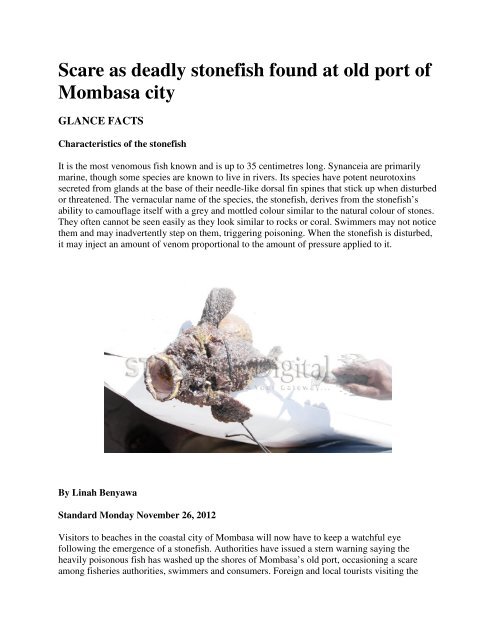





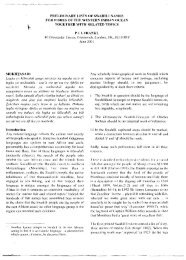

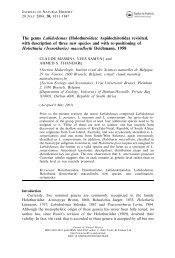


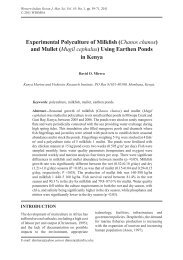

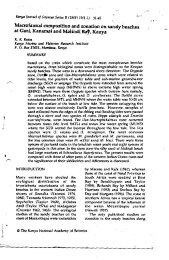
![MSc. Thesis - Lang'at[1].pdf](https://img.yumpu.com/10016993/1/184x260/msc-thesis-langat1pdf.jpg?quality=85)